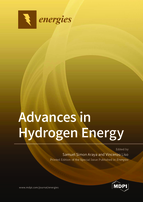Advances in Hydrogen Energy
A special issue of Energies (ISSN 1996-1073). This special issue belongs to the section "A5: Hydrogen Energy".
Deadline for manuscript submissions: closed (31 March 2021) | Viewed by 84890
Special Issue Editors
Interests: PEM fuel cells; PEM water electrolysis; methanol reforming; energy technology; hydrogen
Special Issues, Collections and Topics in MDPI journals
Interests: energy systems modeling; fuel cells; hydrogen; methanol
Special Issues, Collections and Topics in MDPI journals
Special Issue Information
Dear Colleagues,
Hydrogen energy research and development has attracted growing attention as one of the key solutions for a clean future energy system. In order to reduce greenhouse gas emissions, national governments across the world are developing ambitious policies to support hydrogen technology, and an increasing level of funding has been allocated for projects of research, development, and demonstration of this technology. At the same time, the private sector is capitalizing on the opportunity with larger investments in hydrogen technology solutions.
While intense research activities have been dedicated to this field, several issues require further research prior to achieving a full commercialization of hydrogen technology solutions. This Special Issue seeks to contribute to disseminating the most recent advancements in the field with respect to both modeling and experimental analysis. The focus is placed on research covering all aspects of the hydrogen energy route, including fuel production, storage, transportation, and final usage. This also includes the development of hydrogen-based fuels, such as ammonia, alcohols, and methane.
We look forward to considering your submissions.
Assoc. Prof. Samuel Simon Araya
Assoc. Prof. Vincenzo Liso
Guest Editors
Manuscript Submission Information
Manuscripts should be submitted online at www.mdpi.com by registering and logging in to this website. Once you are registered, click here to go to the submission form. Manuscripts can be submitted until the deadline. All submissions that pass pre-check are peer-reviewed. Accepted papers will be published continuously in the journal (as soon as accepted) and will be listed together on the special issue website. Research articles, review articles as well as short communications are invited. For planned papers, a title and short abstract (about 100 words) can be sent to the Editorial Office for announcement on this website.
Submitted manuscripts should not have been published previously, nor be under consideration for publication elsewhere (except conference proceedings papers). All manuscripts are thoroughly refereed through a single-blind peer-review process. A guide for authors and other relevant information for submission of manuscripts is available on the Instructions for Authors page. Energies is an international peer-reviewed open access semimonthly journal published by MDPI.
Please visit the Instructions for Authors page before submitting a manuscript. The Article Processing Charge (APC) for publication in this open access journal is 2600 CHF (Swiss Francs). Submitted papers should be well formatted and use good English. Authors may use MDPI's English editing service prior to publication or during author revisions.
Keywords
- Fuel cell materials and systems
- Electrolysis materials and systems
- Catalysis
- Hydrogen storage and transportation
- Hydrogen based electro-fuels (e.g., methanol, ammonia, enriched methane)
- Control and diagnostics
Related Special Issue
- Advances in Hydrogen Energy III in Energies (12 articles)







